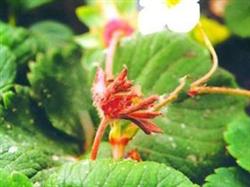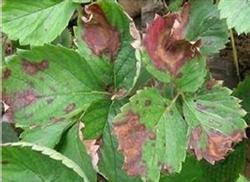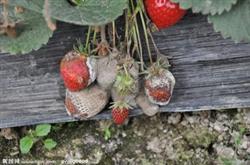Symptoms and integrated control of strawberry bud blight

Strawberry bud blight is a worldwide soil fungal disease, which is highly saprophytic in soil, and is an important root disease of many kinds of crops. in addition to strawberry, it also harms more than 160 cultivated and wild plants, such as cotton, soybean, vegetable and so on. There are mainly harmful buds, new buds, stipules and petioles on strawberries, which cause withering at seedling stage, stem and leaf rot at adult stage, root rot and fruit rot, etc. The main results are as follows: 1. the pathogen of strawberry bud blight belongs to Rhizoctonia, and the sexual stage is basidiomycete subphylum, membranous grass bacteria. The disease at the base of the plant occurs in part of the primary matte brown spot near the ground, gradually sunken, and grows beige to light brown spider nest mycelia, which can sometimes attach several leaves together, and when invading the petiole base and stipules, the erect leaves of the diseased part are withered and drooping. The inflorescence was damaged before flowering, which made the inflorescence lose its vitality and gradually withered and withered, showing a state of collapse at the time of acute onset. Buds and new buds wilted gradually after infection, showing wilt or quenching, and then turned dark brown and withered. The base of the stem and root are damaged by cortical rot, and the aboveground part is dry and easy to pull up. From young fruit, green fruit to ripe fruit can be infringed, the affected fruit surface appears dark brown irregular patches, stiff, and finally the whole fruit dry rot. The above mycelium can grow when the temperature is high, the colored berries become sick, the diseased part turns brown, the red part often changes to rouge red, the color contrast is strong and bright, causing wet rot or dry rot, but not gray mildew, which is the difference from gray fruit rot. 2. The pathogen of strawberry bud blight is Rhizoctonia, which overwinters with mycelium or sclerotia in the soil, and mainly spreads with diseased seedlings and diseased soil. When cultivated in the open field, the disease is mainly in spring, and the optimum temperature for the disease is 22-25 ℃. It is easy to get sick under the condition of fat and heavy water. The protected ground has high temperature, poor ventilation and high humidity, and too dense planting can easily lead to the spread of diseases. Third, prevention and control methods 1, try to avoid raising seedlings and planting strawberries in the areas where the blight occurs, otherwise solar energy must be used for soil disinfection. 2. Proper sparse planting and reasonable irrigation to ensure ventilation and reduce environmental humidity. 3. The protected area should be ventilated timely and ventilated quickly after irrigation to reduce indoor humidity. 4. pull out the diseased plant in time, and it is strictly forbidden to use the diseased plant as the mother plant to propagate strawberry seedlings. 5. Chemical control. The suitable medicament has more than 10% antimycin wettable powder 500 times 1000 times liquid, 10% Likuling water suspension 300 times liquid, and dicarbendan water solvent 600 times liquid, spraying once every 7 days for a total of 2 times 3 times from the budding stage. Under the condition of cultivation in greenhouse or greenhouse, use 5% chlorothalonil powder 110g / mu, put it in 5 / 180 grams per mu, light it in the evening, close the shed for the night, smoke once in 7 days, and smoke 2 times in a row.
- Prev

Control measures of Strawberry Diseases in greenhouse
Strawberry leaf blight is mainly harmful to petiole, fruit pedicel and calyx. 1. Symptoms. At the initial stage of the disease, dark purple-brown dull spots appeared on the leaves, then expanded into irregular spots, and the color of the edge and center of the spot changed little, so it was difficult to distinguish the symptoms of this disease from that of brown spot. Brown spot and leaf blight.
- Next

Control techniques of pollution-free Diseases and insect pests of Strawberry
Symptoms: strawberry black mold is mainly harmful to nearly mature fruit, if the harvested fruit is not processed and packaged in time, it is more likely to be infected, resulting in a large number of fruit rot. At the beginning of the disease, the fruit showed a light brown water-immersed disease spot, and then quickly softened and rotted, growing gray cotton, upper granular black mold, that is, mycelium and seeds.
Related
- Moge, come on! The staff of the peasant association in the producing area of cantaloupe were frightened when the crowd gathered.
- Causes and Solutions of low Fruit setting rate of Apple
- Symptoms and control measures of passion fruit virus disease
- Fruit growing lesson: how do apple orchards keep high yields?
- Can you build orchards in the mountains? What are the pros and cons?
- How to manage the coloring period of Crisson grape?
- This paper introduces the processing technology of two kinds of fig products.
- How much is a month for retired teachers in rural areas by 2020?
- How can strawberry planting increase sugar content? We should pay attention to management in many aspects.
- What are the cultivation techniques on how to improve the yield of golden fruit?

